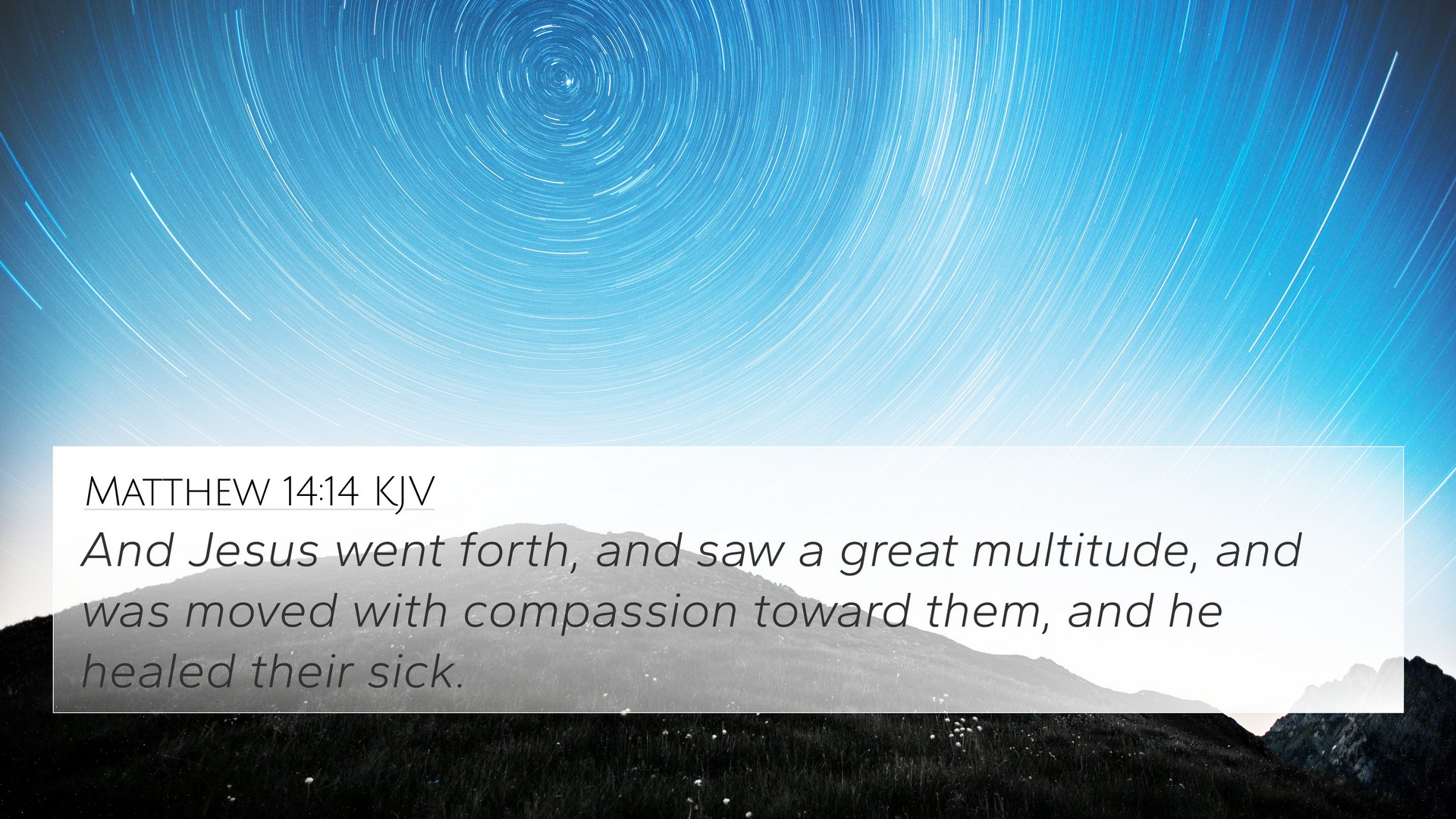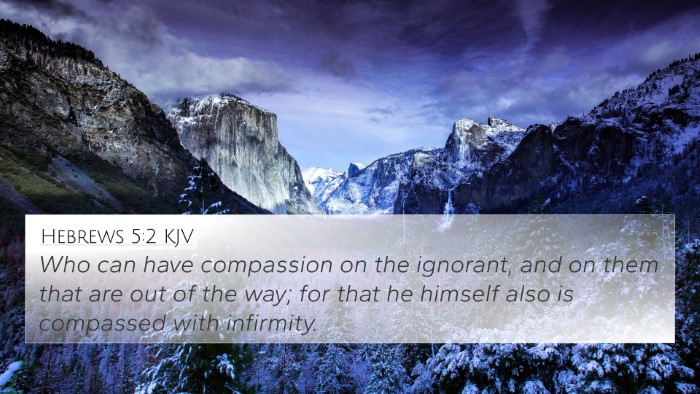Understanding Matthew 14:14
Matthew 14:14 (KJV): "And Jesus went forth, and saw a great multitude, and was moved with compassion toward them, and he healed their sick."
This verse encapsulates a profound moment in the ministry of Jesus, illustrating not only His miraculous healing powers but also His deep compassion for the people. In the context of biblical study, understanding this verse requires a look at its thematic connections, historical background, and the overarching narrative of the Gospels.
Verse Meaning and Context
Matthew Henry's Commentary highlights that Jesus's compassion was a driving force behind His actions. Henry notes how this compassion is not merely emotional but propels Jesus into action, demonstrating His divine nature and care for humanity. This moment comes right after the news of John the Baptist’s death, which may have also stirred feelings of sorrow within Jesus, intensifying His compassionate response to others.
Albert Barnes' Commentary expands on the idea of the "great multitude" as symbolic of the multitude of needs within humanity. His commentary emphasizes the importance of Jesus’s ability to empathize with their suffering, showing that His ministry was characterized by benevolence and grace. Barnes suggests that the healing of the sick is an indication of His authority over illness and disease, reinforcing the belief in Jesus as the Messiah.
Adam Clarke's Commentary also touches on the aspect of compassion, indicating that this moment illustrates the heart of Jesus's mission on earth—to meet the needs of those who are hurting, both physically and spiritually. Clarke notes that healing can be seen as a spiritual parallel to the healing of sin, making an important connection between Jesus’s physical miracles and His larger redemptive work.
Key Themes and Insights
- Compassion: The primary theme in this verse is the compassion of Jesus, highlighting His empathetic nature, which informs much of His ministry (Luke 7:13, Mark 1:41).
- Healing: The act of healing is fundamental in Jesus's mission, showcasing His power over physical ailments and symbolic of spiritual restoration (Isaiah 53:5, Matthew 4:24).
- Divine Authority: This verse illustrates Jesus's authority and ability to perform miracles, fulfilling Old Testament prophecies regarding the Messiah (Isaiah 61:1-2, Matthew 11:5).
- Response to Need: Jesus's actions reflect a model for believers on how to respond to the needs of others, presenting an ideal of selfless service (Philippians 2:4, John 13:14-15).
Bible Cross-References
This verse is intricately connected to several other scriptures that further illuminate its meaning:
- Matthew 9:36: "But when he saw the multitudes, he was moved with compassion..." - This shows a recurring theme of Jesus's compassion for the lost.
- Mark 6:34: "And Jesus, when he came out, saw much people, and was moved with compassion toward them..." - Parallel account, verifying Jesus's response to the people.
- Matthew 15:32: "Then Jesus called his disciples unto him, and said, I have compassion on the multitude..." - Another instance where Jesus expresses His love for the needy.
- Luke 7:12-15: Jesus raises the widow's son, demonstrating His power and compassion in action.
- John 11:35: "Jesus wept." - An instance showcasing Jesus's empathy towards human suffering.
- Isaiah 53:4: "Surely he hath borne our griefs and carried our sorrows..." - A prophetic mention indicating Jesus's physical healing is tied to spiritual healing.
- 1 Peter 2:24: "Who his own self bare our sins in his own body on the tree..." - Emphasizing the broader purpose of Jesus's earthly ministry.
- Matthew 8:17: "That it might be fulfilled which was spoken by Esaias the prophet, saying, Himself took our infirmities, and bare our sicknesses." - Direct fulfillment of prophecy regarding healing.
Connections Between Bible Verses
When we study Matthew 14:14 in the light of these cross-referenced verses, we observe a tapestry of connections that enhances our understanding of Jesus’s character and mission.
Using tools for Bible cross-referencing, believers can explore how these themes of compassion and healing are echoed throughout scripture, facilitating a deeper and richer Bible study experience.
The interconnectedness of scriptures allows for a comparative Bible verse analysis that reveals how Jesus embodies the principles seen throughout the Old and New Testaments, reinforcing His role as the long-awaited Messiah.
Application for Believers
In contemporary application, Matthew 14:14 serves as a reminder of the Christian calling to embody compassion in our own lives, reaching out to the sick, the needy, and those in distress. It challenges believers to reflect Jesus’s love through their actions and inspires a commitment to serve others selflessly.
Conclusion
Matthew 14:14 provides a profound insight into the heart of Jesus's ministry—His compassion leads to healing and signifies the holistic approach of His salvific work. By engaging with this verse and its cross-references, believers can cultivate an understanding of how compassion is intertwined with faith and service. Studying the connections between this and other scriptures not only enriches our biblical knowledge but also encourages a faithful response to the needs of others, aligning our lives more closely with that of Christ.














